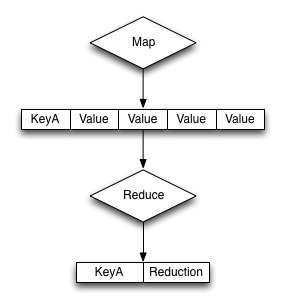Custom Reduce Functions
- concept
Thereduce()function has to work slightly differently to themap()function.
In the primary form, a reduce() function must convert the data supplied to it from the corresponding map() function.
The core structure of the reduce function execution is shown the figure below.

The base format of the reduce() function is as follows:
function(key, values, rereduce) {
…
return retval;
}
The reduce function is supplied three arguments:
-
key
The key is the unique key derived from the map() function and the group_level parameter.
-
values
The values argument is an array of all of the values that match a particular key.
For example, if the same key is output three times, data will be an array of three items containing, with each item containing the value output by the emit() function.
-
rereduce
The rereduce indicates whether the function is being called as part of a re-reduce, that is, the reduce function being called again to further reduce the input data.
When rereduce is false:
* The supplied `key` argument will be an array where the first argument is the `key` as emitted by the map function, and the `id` is the document ID that generated the key. * The values is an array of values where each element of the array matches the corresponding element within the array of `keys`.
When rereduce is true:
* `key` will be null. * `values` will be an array of values as returned by a previous `reduce()` function.
The function should return the reduced version of the information by calling the return() function.
The format of the return value should match the format required for the specified key.